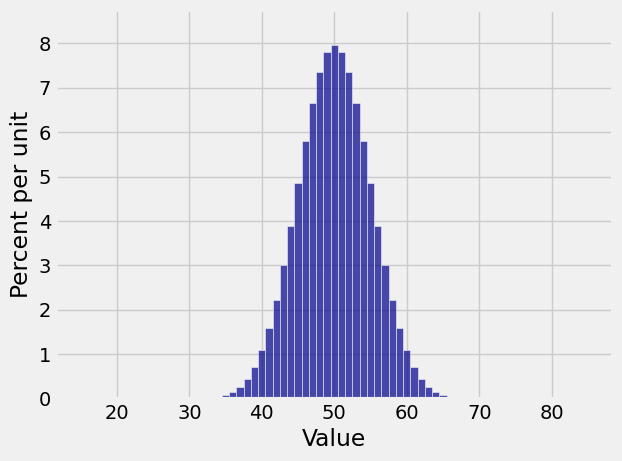10.4. Examples#
Here are two examples to illustrate how to find the stationary distribution and how to use it.
10.4.1. A Diffusion Model by Ehrenfest#
Paul Ehrenfest proposed a number of models for the diffusion of gas particles, one of which we will study here.
The model says that there are two containers containing a total of
Let
The chain is clearly irreducible. It is aperiodic because
Question: What is the stationary distribution of the chain?
Answer: We have computers. So let’s first find the stationary distribution for
N = 100
states = np.arange(N+1)
def transition_probs(i, j):
if j == i:
return 1/2
elif j == i+1:
return (N-i)/(2*N)
elif j == i-1:
return i/(2*N)
else:
return 0
ehrenfest = MarkovChain.from_transition_function(states, transition_probs)
Plot(ehrenfest.steady_state(), edges=True)

That looks suspiciously like the binomial (100, 1/2) distribution. In fact it is the binomial (100, 1/2) distribution. Let’s solve the balance equations to prove this.
The balance equations are:
Now rewrite each equation to express all the elements of
and so on by induction:
This is true for
Therefore the stationary distribution is
In other words, the stationary distribution is proportional to the binomial coefficients. Now
So
10.4.2. Expected Reward#
Suppose I run the sticky reflecting random walk from the previous section for a long time. As a reminder, here is its stationary distribution.
stationary = reflecting_walk.steady_state()
stationary
| Value | Probability |
|---|---|
| 1 | 0.125 |
| 2 | 0.25 |
| 3 | 0.25 |
| 4 | 0.25 |
| 5 | 0.125 |
Question 1: Suppose that every time the chain is in state 4, I win 4 dollars; every time it’s in state 5, I win 5 dollars; otherwise I win nothing. What is my expected long run average reward?
Answer 1: In the long run, the chain is in steady state. So I expect that on 62.5% of the moves I will win nothing; on 25% of the moves I will win 4 dollars; and on 12.5% of the moves I will win 5 dollars. My expected long run average reward per move is 1.65 dollars.
0*0.625 + 4*0.25 + 5*.125
1.625
Question 2: Suppose that every time the chain is in state
Answer 2: Each time the chain is in state
stationary.ev()/2
1.5000000000000022
If that seems artificial, consider this: Suppose I play the game above, and on every move I tell you the number of heads that I get but I don’t tell you which state the chain is in. I hide the underlying Markov Chain. If you try to recreate the sequence of steps that the Markov Chain took, you are working with a Hidden Markov Model. These are much used in pattern recognition, bioinformatics, and other fields.

